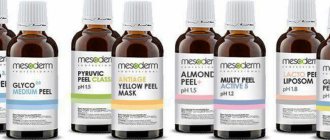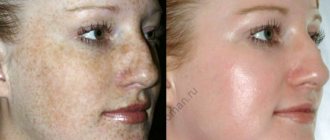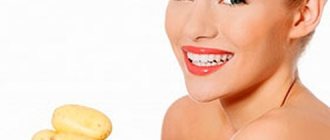From this article you will learn:
- What is enzyme peeling
- What is enzyme peeling used for?
- What enzymes are included in peelings?
- Who is contraindicated for enzyme body peeling?
- How does the enzyme body peeling procedure work in a beauty salon?
- Is it possible to do enzyme peeling at home?
Exfoliation is a superficial procedure for exfoliating or removing dead skin cells from the outer layer of skin to stimulate the growth of new ones. The most suitable for all types of dermis is the enzymatic or enzyme composition. Let's figure out what it is - enzyme body peeling.
The essence of enzyme peeling
This term refers to surface peeling, in which the role of the active elements is performed by enzymes, not acids. This manipulation produces a rather gentle effect on the skin. It is suitable for all types of dermis. Therefore, the technique is recommended even for those with sensitive epithelium with rosacea.
The principle of such peeling is aimed at gently cleansing the epithelium of dirt, dead cells and secretions. Thanks to this type of manipulation, the skin becomes smoother and acquires a beautiful shade. After the procedure there is no need for restorative procedures or specific care. It does not cause redness or peeling.
Peeling is a good solution for those with young skin. It has pronounced cleansing, protective and moisturizing properties. The procedure can be used for women with aging skin. Thanks to this, it is possible to activate regeneration processes. Enzyme peeling will help restore lost tone and improve the shade of the dermis.
In addition, the procedure successfully copes with age spots and acne. It can be used if you are prone to allergies and inflammatory processes. The manipulation is also suitable for women who suffer from rosacea or rosacea.
Risks and side effects
Can Digestive Enzymes Be Dangerous? If you suffer from chronic diseases, we recommend that you consult a doctor who can select the most suitable enzymes for you.
Depending on your health condition, a specialist will be able to prescribe the safest medications. If you have suffered or are suffering from liver or gallbladder diseases, or ulcers, be sure to consult your doctor before taking supplements.
Despite all the benefits, digestive enzymes can cause side effects, including:
- nausea
- diarrhea
- cramps in the abdomen
- gases
- headache
- edema
- dizziness
- changes in blood sugar levels
- allergic reaction
- change in stool
If you notice these symptoms, stop taking enzymes and consult your doctor.
Most often, undesirable consequences occur when the dosage is too high or the drug is taken incorrectly. For this reason, it is important to read the instructions before use.
Advantages and disadvantages
The key advantages of the procedure include the following:
- Soft impact. If you compare this type of peeling with the effect of fruit acids, you can achieve a more gentle effect. Enzymes cause less damage and irritation to the skin.
- Weakening of hair follicles. The procedure helps slow down facial hair growth.
- Possibility of use at different times of the year. This peeling can be done without taking into account sun activity. Moreover, it is suitable not only for the face, but also for other parts of the body.
- No abrasive elements in the composition. Due to this, peeling has a gentle and superficial effect. Therefore, the product can be used even for rosacea and a tendency to allergies.
- The procedure can be performed if you are overly sensitive to alpha hydroxy acids or have no effect from other types of peeling. The manipulation can also be carried out during pregnancy and breastfeeding.
- Quick effect. The procedure does not take much time and provides quick results. Subsequently, there is no risk of painful recovery or severe peeling of the dermis.
- Possibility of use at home. On sale you can find many ready-made cosmetics that allow you to carry out enzyme peeling.
After peeling, it is possible to reduce pores and cope with post-acne symptoms. The procedure increases the tone of the dermis and improves its relief. With its help you can cope with fine wrinkles, moisturize the epithelium and make your face look fresher.
At the same time, enzyme peeling also has certain disadvantages. These include the following:
- The need for several procedures. This allows you to achieve a more noticeable effect.
- Deterioration of the dermis. This occurs when the required number of procedures is exceeded.
- Inability to eliminate serious defects. Enzyme peeling does not help eliminate severe pigmentation, deep wrinkles, and severe post-acne.
- Risk of side effects. During the procedure, aggravation of acne may occur. Also, this type of peeling can provoke symptoms of allergic and seborrheic dermatitis.
How do digestive enzymes work?
Digestion is a complex process that begins with chewing food, when enzymes are released into saliva. Most of the work is done by the gastrointestinal fluids, which contain digestive enzymes that affect certain nutrients (fats, carbohydrates and proteins).
By producing specific enzymes, we help absorb various types of food. In other words, our body produces enzymes specific for carbohydrates, proteins and fats.
Digestive enzymes are not just useful, they are vital. They convert complex foods into easily digestible compounds, including amino acids, fatty acids, cholesterol, simple sugars and nucleic acids (which help build DNA).
Enzymes are synthesized and secreted in various parts of the digestive tract, including the mouth, stomach and pancreas.
Below we have described in a little more detail the 6 main stages of the digestion process, which begins with chewing, which triggers the secretion of digestive enzymes in the gastrointestinal tract:
- Salivary amylase, produced in the mouth, is the first digestive enzyme involved in the absorption of molecules. And this process continues after the food enters the stomach.
- The parietal cells of the stomach then begin to release acids, pepsin and other enzymes, including pancreatic amylase. The process of breaking down partially digested food into chyme (a semi-liquid mass of partially digested food) begins.
- Gastric juice neutralizes the action of salivary amylase, promoting the work of pancreatic amylase.
- After about an hour, the chyme moves into the duodenum, where acidity causes the release of the hormone secretin.
- This in turn causes the pancreas to produce hormones, bicarbonate, bile and various digestive enzymes, the most important of which are lipase, trypsin, amylase and nuclease.
- Bicarbonate changes the environment of the chyme from acidic to alkaline, which not only allows enzymes to break down food, but also kills bacteria that cannot survive in such conditions.
At this stage, most of the work is done. However, people suffering from digestive enzyme deficiencies need support in the form of nutritional supplements.
There are even digestive enzymes for sale for cats and dogs, because animals can also suffer from this disease.
Classification of enzymes
Enzymes are characterized by specific properties. The elements have different effects on the skin. Enzymes can be plant, animal, or bacterial. Plant elements are most often obtained from fruits. Beneficial components are also present in berries.
The following substances are used for enzyme peeling:
- Papain – This enzyme is obtained from papaya. The substance is most often found in enzyme peeling products. The element ensures exfoliation of dead cells. At the same time, it perfectly saturates the epithelium with useful elements.
- Bromelain is a rather complex molecule. The element is present in pineapple. It helps eliminate small wrinkles on the face and copes with age spots.
- Actinidin is a kiwi enzyme. With its help, it is possible to make the walls of blood vessels stronger. Therefore, the substance is actively used to eliminate rosacea. The element also helps cleanse and reduce pores.
- Ficin is an element present in the cells of fig tree leaves. It helps stimulate collagen synthesis processes. This substance is present in the cells of the human body. However, as we age, it is produced in less quantity. As a result, the skin sags. Thanks to collagen, it is possible to increase the elasticity of the dermis.
- Arbutin is a substance present in mulberries and lingonberries. The element has lightening properties. It helps eliminate pigmentation.
Animal enzymes are also actively used to make all kinds of enzyme peels. These include the following:
- Trypsin is an element obtained from veal pancreas. The product has healing properties and perfectly disinfects the skin.
- Muramidase - this enzyme is obtained from egg whites. It stops inflammation and has a bactericidal effect. Products with this enzyme help disinfect the epithelium and successfully treat acne.
- Pepsin is a key component of enzyme peeling. The element is excreted from the stomach of pigs or sheep. It is also obtained from the bodies of cows and horses.
Enzymes obtained from fermented milk products are of great importance for the full implementation of peeling. They soften the skin and saturate it with useful substances.
The most effective elements include the following:
- Subtilisin - activates regeneration processes in the structure of the dermis.
- Grass - is an active element that ensures the separation of the dead layer of dermis. Products with Travase provide relief from pigmentation.
Facial peeling – why it is the best procedure.
Exfoliation is a unique procedure that allows you to rejuvenate your facial skin and do something that no other procedure can do. Each of the peels has its own peculiarity; enzyme peeling for the face differs from chemical and mechanical peeling. But their common secret is the natural rejuvenation of the skin after removing the top layer of the epidermis.
| Exfoliation starts the rejuvenation process. When the upper layer of the epidermis is removed, the mechanism of our skin signals the lower layer, where new cells are born, that it is time to renew itself. |
The exfoliation procedure is carried out at any age. At a young age, using exfoliation may be necessary to more effectively cleanse blemish-prone skin by unclogging pores and removing excess sebum.
In older age, exfoliation evens out the texture and gives the face a fresher, more youthful appearance. Stimulates renewal processes that are not as active as before. Makes the skin more receptive to further care and application of moisturizing and nourishing cosmetics.
Peelings acquire particular relevance and priority in home care, where the use of cosmetological hardware techniques is limited.
The great thing about exfoliating is that it can be tailored to suit different skin types and concerns, achieving maximum effectiveness with minimal risk of irritation.
You can read more about exfoliation in the following articles:
What is facial peeling? You can’t get this effect in any other way.
Acid peeling for face.
Summer facial peels are possible, if you know which ones.
Exfoliation of the top layer can be done in different ways. The active substance can be abrasive particles, acids, enzymes. In this article, we will get acquainted with enzyme peeling, in which the active substance that breaks down the bonds between horny particles are enzymes, also known as enzymes.
Enzymes or enzymes, the meanings of these words are the same - yeast, leaven. The word enzymes is of Greek origin, enzymes, the same meaning, but in Latin. Both are venerable and respected, but the term has taken root in cosmetics - enzyme peeling.
Indications
Key indications for performing the procedure include the following:
- increased density of the dermis due to the accumulation of excess dead cells;
- high dryness or fat content of the epithelium associated with damage to the sebaceous glands;
- symptoms of premature withering of the epithelium - these include weakening of tone, dull shade, uneven relief;
- acne;
- post-acne;
- the appearance of pigmentation;
- rosacea;
- small facial wrinkles.
Enzyme peeling can be performed to regenerate the dermis and prevent premature aging. It is actively used by cosmetologists to prepare for deeper peeling and other procedures.
Benefit for health
What are the benefits of digestive enzymes? Mainly because they help digest food. Enzymes should be taken for the following reasons:
- Help treat leaky gut and other conditions by relieving tension in the gastrointestinal tract.
- Maintains a healthy balance of bacteria in the intestines.
- Helps the body break down difficult-to-digest proteins and sugars, such as gluten, casein and lactose (milk sugar).
- Significantly reduces the symptoms of acid reflux and irritable bowel syndrome.
- Improves nutrient absorption, preventing the development of deficiencies.
- Naturally blocks the action of enzyme inhibitors found in foods such as nuts, wheat germ, egg whites, seeds, beans and potatoes.
If you lack digestive enzymes, you may experience constipation. In this case, taking additional enzymes may help. Digestive enzymes are not associated with weight loss and cannot be used for weight loss. However, they can help eliminate cravings for certain foods and help you feel full more quickly.
Technique
In order for enzyme peeling to give good results, it is necessary to carefully prepare for it. A day before the session, you should stop using products that contain acids and retinol. It is also necessary to exclude depilation. It is prohibited to carry out the procedure after laser resurfacing or dermabrasion. It is important to wait until the epithelium is completely regenerated.
Before the first peeling session, you need to perform a sensitivity test. To do this, it is recommended to apply the substance to your wrist and hold for 10 minutes. If there is no allergy, you should start using the composition.
To perform peeling you need to do the following:
- Cleanse skin with makeup remover substances. To do this, you need to choose products taking into account your skin type.
- Apply peeling composition. It is recommended to cover the forehead and cheeks first. Then move on to the chin, cheekbones, nose. Finally, treat the eyelids, lips and neck. Certain formulations are prohibited from being applied to the eyelids and lips. It is recommended to keep the product for 10-30 minutes. To activate the enzymes, you need to cover your face with a film or a wet towel. Sometimes cosmetologists additionally perform massage.
- Rinse off the product with warm water. If it contains acids, it becomes necessary to use an alkaline neutralizer.
- Apply a mask. When choosing it, you need to take into account the characteristics of the epithelium. Active serums are also an excellent option.
- Apply cream. It is recommended to choose this product according to your skin type. It is important that it contains an ultraviolet protection factor.
During the session, a slight burning and tingling sensation occurs. After completing the session, these symptoms will go away on their own. Some women experience redness of the skin. It should go away after half an hour. To increase the effectiveness of enzyme peeling, it is worth combining manipulation with darsonvalization. You can also supplement it with facial cleansing and alpha hydroxy acids.
Enzyme peeling can serve as a preparatory step for serious interventions. These include microcrystalline dermabrasion and laser resurfacing. This category includes medium peels and other procedures. The course includes 5-8 sessions. They need to be carried out 1-2 times a week. Professional peels usually contain acids. They are done with an interval of 7-10 days. The course includes 5-10 sessions.
When should you take digestive enzymes?
For optimal results, digestive enzymes should be taken 10 minutes before meals or with your first bite. Protease supplements can be taken between meals in combination with other enzymes.
Start with twice daily and adjust dosage as needed.
Can I take probiotics and digestive enzymes at the same time?
Yes, enzymes should be taken before meals, and probiotics after or between meals.
It is beneficial to get probiotics from fermented foods. For example, yoghurt, kefir, kimchi or sour cream. Probiotics help normalize the gut microbiome, aiding digestion and reducing symptoms such as gas and bloating.
Manufacturers of enzyme peeling
To make home enzyme peeling, you should use ready-made cosmetic compositions in the form of gels and masks. They include enzyme components. The cost of products varies significantly. The price of such funds varies from 100 to 3000 rubles. The most popular means include the following:
I am the
This product contains many useful components - papain, aloe, minerals. It also contains vitamins C, F and E. The substance can be used for dry epithelium. It copes well with irritation and has calming properties.
Stopproblem
This gel is made on the basis of salicylic acid. It is considered one of the most affordable and popular peeling compositions. The substance successfully eliminates sebaceous shine and restores the functions of the glands. Salicylic enzyme peeling helps reduce the sensitivity of the dermis and eliminate inflammation.
Myrrh
The substance includes enzymes and natural preservatives. The product has a gel structure. This greatly simplifies its use.
Klapp
The composition refers to professional products. However, it can also be used at home. The composition contains a unique component - thyme cell extract. It is very beneficial for the skin. It is recommended to apply the peeling composition after a shower, when the skin is well steamed.
GiGi
This gel provides dramatic results. It contains several types of enzyme components. These include papain, lipase, protease. It also contains amylase. Additionally, the gel includes citric acid, vitamin C, and urea. It helps cleanse and whiten the skin. The composition also differs in its exfoliating effect. It can be used not only for the face. Actively use the product on your hands. It can also be used to treat the neck and décolleté area.
Janssen
This composition with enzymes is an excellent solution for those with sensitive dermis. Its application has certain features. After the required time, the composition is not washed off. It must be washed with napkins or hands until shine appears. In beauty salons, the substance is often used at the stage of preparation for other procedures. At home, the composition should be used in courses. The duration of each of them is 2 weeks.
Who needs enzymes? (Signs of Deficiency)
The answer to this question may involve many more people than you might suspect.
Symptoms such as bloating, gas, abdominal pain and fatigue may be due to an inability to fully digest food. In this case, these people may benefit from taking additional digestive enzymes. Other signs indicating an enzyme deficiency may include:
- Acid reflux
- Dyspepsia (pain or discomfort in the upper stomach area)
- Cravings for certain foods
- Thyroid problems
- Heartburn, indigestion, belching
- Thinning and hair loss
- Dry or dull skin
- Concentration problems or brain fog
- Fatigue in the morning
- Sleep problems
- Arthritis or joint pain
- Muscle weakness, fatigue before exercise
- Mood swings, depression and irritability
- Headaches and migraines
- Worsening PMS symptoms
People with the following conditions may feel better with supplemental digestive enzymes:
Digestive diseases
If you suffer from any gastrointestinal condition such as acid reflux, gas, bloating, leaky gut, irritable bowel syndrome (IBS), Crohn's disease, ulcerative colitis, diverticulitis, malabsorption, diarrhea or constipation, then digestive enzymes can help you.
They can “calm” the digestive organs, reduce abdominal pain and bloating, which are associated with intestinal diseases.
Age-related enzyme deficiency
As we age, the environment in the stomach becomes more alkaline, which prevents the pancreas from producing enough enzymes.
In addition to concomitant diseases, the risk of developing digestive problems associated with a lack of gastric juice or digestive enzymes increases with age. Quite often this leads to acid reflux.
Hypochlorhydria
Hypochlorhydria (insufficient stomach acid) makes it difficult to absorb minerals, vitamins and other elements from food, resulting in nutritional deficiencies.
Liver diseases and other enzyme-related diseases
Liver diseases often result in a concomitant deficiency of digestive enzymes. The most common is alpha-1 antitrypsin deficiency, a genetic disorder that affects one in 1,500 people.
Symptoms may include unintentional weight loss, recurring respiratory infections, fatigue and rapid heartbeat.
Diseases whose diagnosis may not be associated with reduced production of digestive enzymes include:
- Crohn's disease
- Iron or vitamin B12 deficiency
- Vitamin D deficiency
Symptoms of enzyme deficiency may also include:
- Changes in stool. The stool may become paler, greasy, or float.
- Complaints related to the gastrointestinal tract. Bloating, diarrhea, especially within an hour after eating, flatulence and indigestion may be signs of enzyme deficiency.
Pancreatic insufficiency
Pancreatic insufficiency is the inability of the pancreas to secrete enzymes needed for digestion. This is a common problem among people with pancreatic cancer.
Taking medications containing pancreatic enzymes (replacement therapy) may be useful for patients with pancreatic cancer, chronic pancreatitis, cystic fibrosis, and patients who have had bowel surgery to speed up healing.
Natural springs
Many raw vegetables and fruits contain enzymes that improve digestion.
Raw fruits and vegetables grown in good, nutritious soil are the best natural sources of digestive enzymes. Try to include foods such as:
- a pineapple
- papaya
- kiwi
- kefir
- yogurt
- bananas
- mango
- miso, soy sauce and tempeh (fermented soy products)
- sauerkraut
- kimchi
- avocado
- Apple vinegar
- raw honey
- bee pollen
Digestive enzyme products are primarily manufactured using the following sources:
- Fruits are mainly pineapple and papaya. Bromelain, an enzyme derived from pineapple, breaks down a wide range of proteins, has anti-inflammatory properties and can withstand a wide range of pH (acid-base). Papain, an enzyme obtained from fresh papaya, is effective in breaking down both small and large proteins.
- Animals. These drugs include pancreatin, obtained from bovine or pig sources.
- Plants. These drugs are derived from probiotics, yeast and fungi.
Efficiency of the procedure
Already after the first session you can achieve noticeable results. However, a significant effect can be obtained only after completion of the course of therapy. Thanks to enzyme peeling, it is possible to obtain the following results:
- cleanse the dermis of dead cells and dirt;
- reduce wrinkles;
- improve the shade of the epithelium;
- tighten pores;
- give the skin smoothness and softness;
- cope with post-acne.
Enzyme peeling is an effective procedure that helps improve the condition of facial skin, making it smoother and softer. To achieve optimal results, it is very important to use the enzyme composition correctly and take into account all contraindications to its use.
Reviews
Enzyme peeling is a familiar procedure for a large number of women who leave their reviews about it. Patients claim that this skin rejuvenation technique has no side effects.
Thanks to the manipulation, rejuvenation of spots is ensured, skin tone is evened out, as well as the fight against acne and pimples.
Patients confirm in their reviews that with the help of manipulation all of the above problems can be solved. Women say that the procedure is as simple as possible and therefore they often perform it at home.











